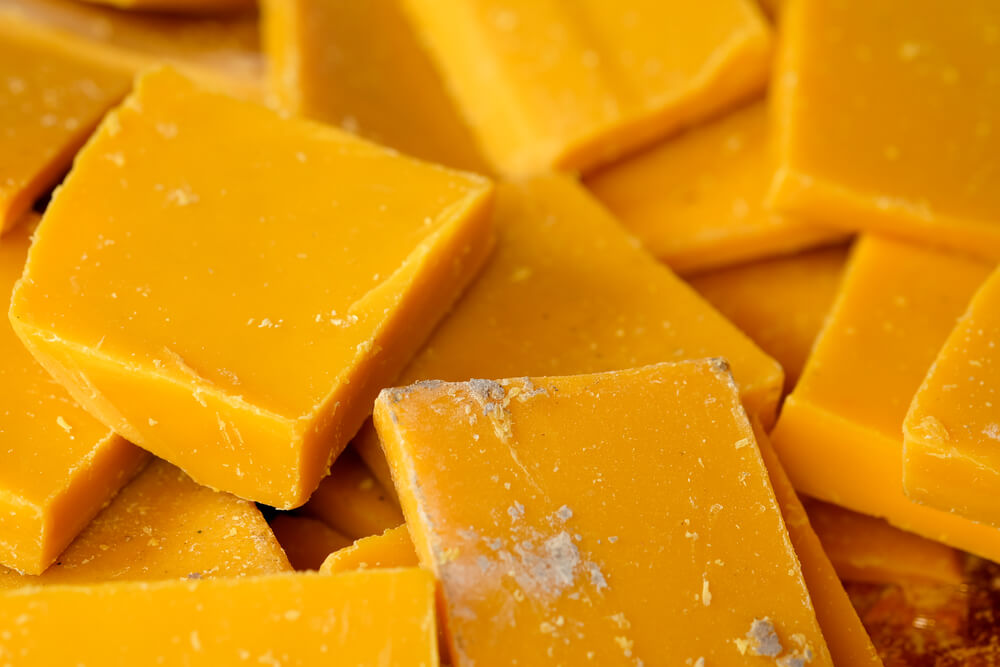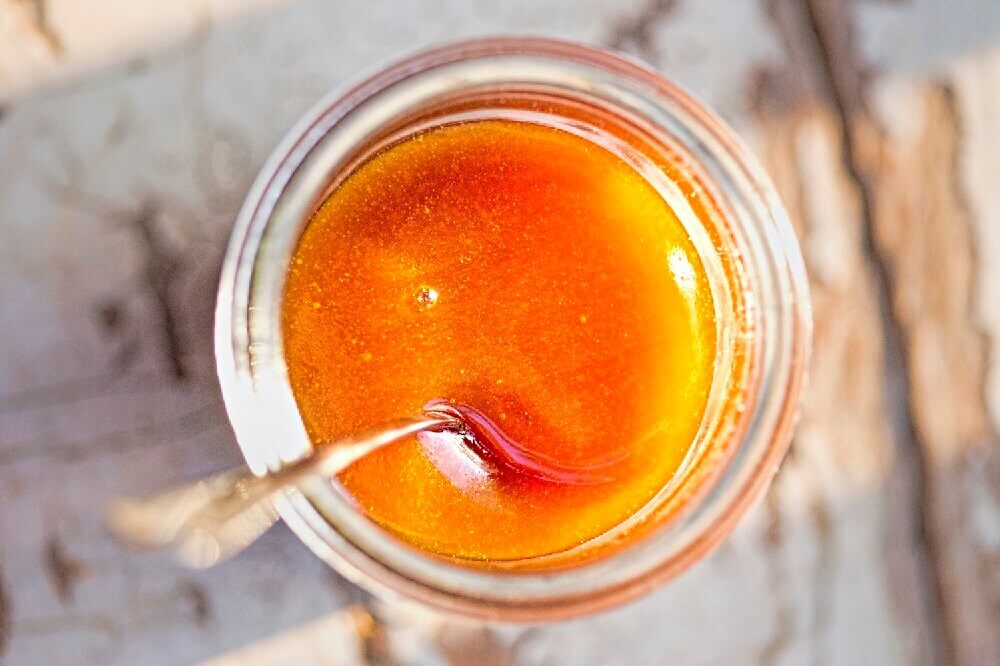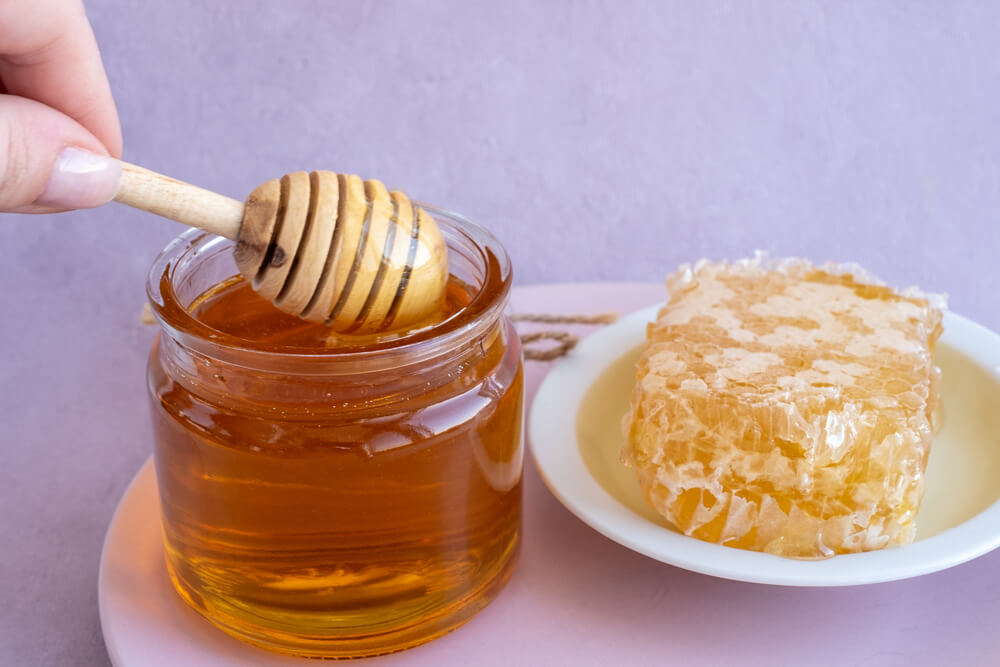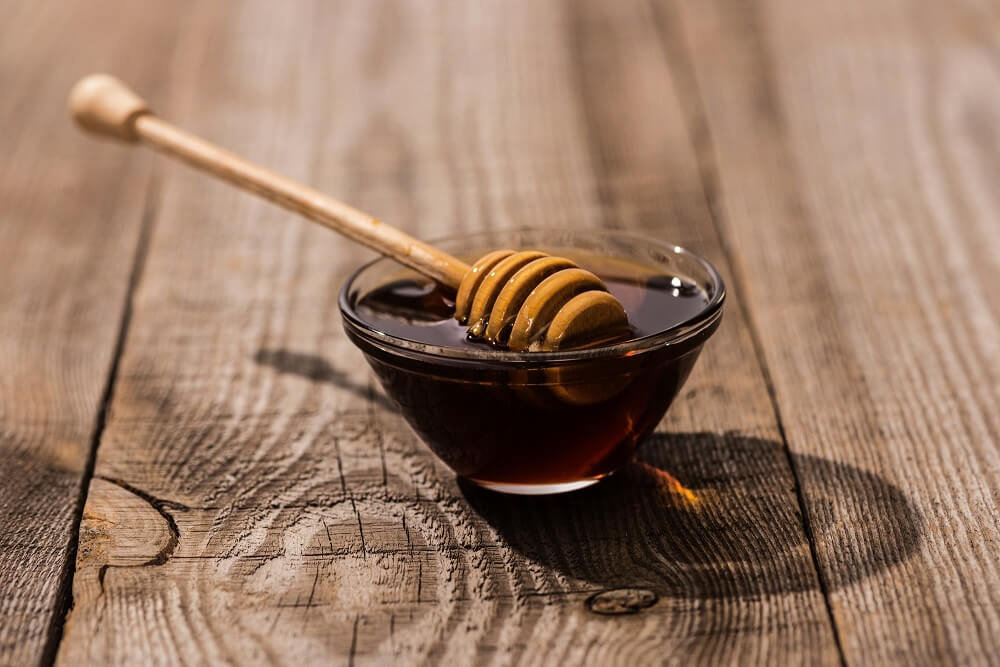What’s the Melting Point of Beeswax?
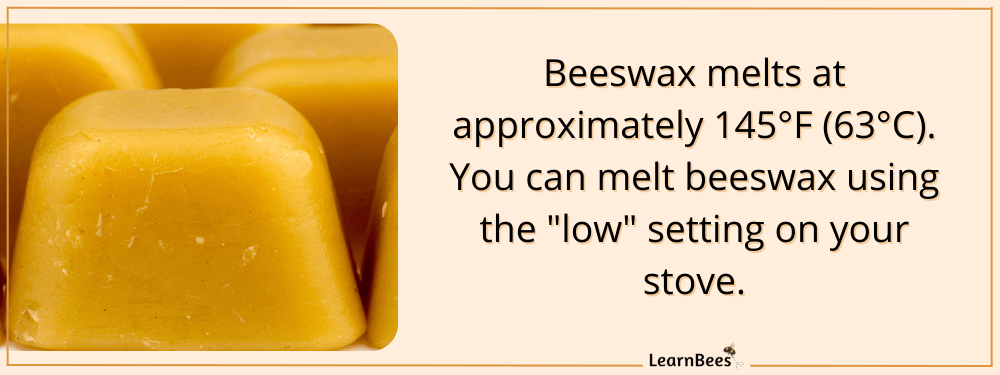
Beeswax has a melting point of about 145° Fahrenheit and 63° Celsius.
You don’t want to overheat beeswax because it can scorch and change colors. As a result, you must monitor your beeswax carefully, so it doesn’t overheat or bubble over the pot.
With that in mind, the easiest way to melt beeswax is over the stove. Beeswax typically won’t melt in hot water. This is because most water heaters are set for around 120° F (49°C), which isn’t hot enough to reach the melting temperature of beeswax.
How to Melt & Filter Beeswax
Cleaning the beeswax through melting and filtering is called rendering beeswax.
Cleaning beeswax is important because it removes debris from the wax. This way, you’re left with a smooth, clean bar of beeswax.
Step 1: Grab a Large Pot and a Small Pot
We use the double boiler method to melt the beeswax.
The double boiler method uses two pots, one nested inside the other. The big pot contains water, and the smaller pot contains the beeswax. Double boilers provide better temperature control.
Step 2: Fill the Large Pot Halfway With Water
Turn your stove temperature on low and fill your large pot about halfway with water. Place your smaller pot in the large pot. Next, pour the beeswax into the small pot.
We recommend using cheap pots because they can be hard to clean once beeswax has been melted in them.
Step 3: Gradually Melt Your Beeswax Uncovered
This step can take up to one hour on the “low” stove setting. You don’t need to bring the wax to a boil because you don’t want to overheat it. Ensure you keep an eye on the wax, so it doesn’t bubble over.
Step 4: Strain Your Beeswax
Place a cheesecloth or paint strainer over a large, empty bowl. Pour your freshly melted beeswax over the strainer so it can filter out any debris.
Step 5: Allow the Beeswax to Sit Overnight
The beeswax will form into a hard block after sitting for several hours. There is no need to refrigerate the beeswax to get it to harden. It’ll harden on its own at room temperature.
However, you can refrigerate the beeswax to speed up the hardening process.
After solidifying, you may notice that additional honey has drained out of the beeswax and is sitting on the bottom. Separate the honey from the hardened block of beeswax. Rinse off the beeswax under cold water.
Step 6: Remelt & Filter the Beeswax One More Time
Repeat steps one through five. This allows you to remove any additional impurities that weren’t filtered out of the beeswax the first time.
FAQs on the Melting Point of Beeswax
- What is the melting point of beeswax in Fahrenheit?
- What is the melting point of beeswax in Celsius?
- What’s the temperature to melt beeswax in the oven?
- Does beeswax melt easily?
- Does beeswax have a high melting point?
- What happens if you overheat beeswax?
- Is burning beeswax toxic?
- Does beeswax melt in hot water?
- Does beeswax melt in the sun?
- How do you melt pure beeswax?
- Can you scorch beeswax?
- Why does beeswax turn black?
- Can I microwave beeswax?
- Does beeswax harden?
- How long do you boil beeswax?
What is the melting point of beeswax in Fahrenheit?
People often ask, “What temperature do you heat beeswax to?”
Beeswax melts between 145-149°F. Beeswax can be heated over the stove on low heat or in a crockpot.
Generally speaking, you can’t melt beeswax in hot water from the kitchen faucet. This is because most water heaters are only set to 120°F, which isn’t hot enough to melt the beeswax. Additionally, hot water from the kitchen faucet cools down quickly.
—> Go back to the FAQs on the melting point of beeswax
More to Explore:
- Honey Pasteurization: Does it Ruin Raw Honey?
- Honey for Skin Benefits: Directions, Uses, & Risks
- 8 Scientific Benefits of Raw Honey
What is the melting point of beeswax in Celsius?
Beeswax melts at about 63°C. The best way to melt beeswax is over the stove using two pots. This is called the double boiler method, where one pot is placed inside the other.
—> Go back to the FAQs on the melting point of beeswax
More to Explore:
What’s the temperature to melt beeswax in the oven?
Most ovens have a lowest temperature setting of 170° F (77°C). You want to melt the beeswax gradually on the lowest oven setting.
With that said, we recommend melting beeswax over the stove instead of in the oven. This way, you can keep an eye on the wax to ensure it doesn’t bubble over or get scorched.
—> Go back to the FAQs on the melting point of beeswax
More to Explore:
Does beeswax melt easily?
Yes, beeswax melts easily, but it does take time. The key to melting beeswax is patience. You don’t want to get in a hurry and accidentally overheat the wax. Overheating your beeswax can cause it to change colors.
You also want to keep an eye on your beeswax as it’s heating. If you’re not careful, the beeswax can bubble over your pot and create a mess.
And remember:
Use pots that you don’t mind getting messy. Melted beeswax can be hard to clean, so use thrift store pots or old pots that you don’t care about. You may have to scrape the leftover beeswax from the bottom of your pot which can cause scratches and imperfections.
—> Go back to the FAQs on the melting point of beeswax
More to Explore:
Does beeswax have a high melting point?
Beeswax has a high melting point compared to paraffin wax. Paraffin wax has a melting point between 115 and 154 °F (46 and 68 °C).
—> Go back to the FAQs on the melting point of beeswax
More to Explore:
What happens if you overheat beeswax?
Overheating your wax will cause it to darken to a brownish or olive color. You’ll lose that beautiful golden shade that beeswax is known for.
As a result, we recommend heating your wax on the lowest setting. The key is to remain patient. It can take up to an hour to melt the beeswax slowly. You want to keep a close eye on the wax, so it doesn’t bubble out of the pot.
—> Go back to the FAQs on the melting point of beeswax
More to Explore:
Is burning beeswax toxic?
There are many articles online stating that burning beeswax candles is toxic. However, many of these articles use inconclusive or no evidence to back such claims.
So, as a result, burning beeswax isn’t considered a threat to human health.
Furthermore, one study funded by the European Candle Association looked at each major type of wax for 300 toxic chemicals. The researchers discovered that the number of chemicals released by each type of candle was well beneath the amount that would cause harm to humans.
Additionally, if you’re burning candles correctly in a well-ventilated area, they’re unlikely to have a big impact on your health.
With that in mind, the smoke is the main thing to consider with any candle. Inhaling too much of any smoke can have adverse effects on your health.
You can minimize the amount of smoke you inhale from candles by keeping them in a well-ventilated room.
—> Go back to the FAQs on the melting point of beeswax
More to Explore:
- The Top 3 Best Manuka Honey Brands
- Orange Blossom Honey: Uses, Benefits, & Risks
- Sourwood Honey: Uses, Benefits, & Risks
Does beeswax melt in hot water?
Melting beeswax in water from the kitchen faucet doesn’t usually work. This is because most water heaters aren’t set high enough to reach the melting point of beeswax. The average water heater is set to 120°F, while beeswax needs at least 145°F to melt.
Additionally, hot water from the kitchen faucet cools down too quickly to actually melt the beeswax.
The easiest way to melt beeswax is to do it over low heat on a stove. We recommend using two pots to heat the wax gradually. One larger pot will be filled halfway with water, while a smaller pot will rest on top. Beeswax will be placed inside the smaller pot until it liquefies.
Melting beeswax is a process that can take anywhere from 30 to 60 minutes. You should melt the beeswax gradually on low heat to avoid overheating it. Overheated beeswax will change from yellow color to a brown or olive color.
—> Go back to the FAQs on the melting point of beeswax
More to Explore:
Does beeswax melt in the sun?
Beeswax may soften in the summer sun, but you won’t be able to melt a whole block of beeswax using the sun alone.
Beeswax will need to be heated over the stove to melt it fully. This will allow you to filter and clean the beeswax since it’s easier to clean beeswax when it’s in liquid form. You can filter the beeswax through a cheesecloth or paint strainer.
Once the beeswax is melted, you can pour it into molds to create candles, lip balms, or other products.
Beeswax is a versatile material that can be used for various purposes. This natural wax has multiple uses, from making candles to creating lip balm. With a high melting point, beeswax can be melted and reformed many times without losing its quality.
—> Go back to the FAQs on the melting point of beeswax
More to Explore:
- The Brutally Honest Truth About Sour Honey
- Buckwheat Honey: Uses, Benefits, & Risks
- Can You Eat Honeycombs?
How do you melt pure beeswax? What is the fastest way to melt beeswax?
The fastest and best way to melt beeswax is over the stove on the “low” setting. Use two pots, one inside the other, to create a double boiler. The larger pot is filled halfway with water, and the smaller pot sits inside it.
Place the beeswax inside the smaller pot and allow it to melt gradually. The process should take about 30-60 minutes.
—> Go back to the FAQs on the melting point of beeswax
More to Explore:
- Cinnamon Honey: Are There Any Health Benefits?
- How to Substitute Honey for Sugar
- Is Honey Acidic or Alkaline?
Can you scorch beeswax? Can you ruin beeswax?
Yes, you can overheat beeswax by turning the temperature too high and heating it for too long. This will cause the beeswax to change colors from yellow to an olive or brown color.
Beeswax has a melting point of 145°F, so it’s best to melt it gradually on low heat to avoid scorching.
—> Go back to the FAQs on the melting point of beeswax
More to Explore:
- Beeswax on Hair: Benefits, Risks, & How to Use It
- Does Honey Need to Be Refrigerated?
- How is Honey Useful?
Why does beeswax turn black?
Beeswax can have a dark color due to debris from the beehive. This is why we recommend melting and filtering the beeswax through a cheesecloth to remove any debris. You may have to repeat the melting and filtering process twice to remove debris from the wax entirely.
Don’t overheat the beeswax because it can cause it to transform from yellow color to a brown or olive color.
—> Go back to the FAQs on the melting point of beeswax
More to Explore:
- Honey for the Face: Can You Apply it to the Skin?
- Beeswax vs. Soy Wax: Which is Better for Candle Making?
- What Is Black Honey?
Can I microwave beeswax?
We don’t recommend trying to melt beeswax in the microwave. For one, beeswax can easily overheat while microwaving it. This can be dangerous and messy. It can explode inside of the microwave or on you.
When heated, the beeswax will burn very hot. That’s why we recommend heating it over “low” heat on the stove and keeping a close eye on it. You don’t want to boil the wax. Simply allow it to heat until the wax is fully liquified gradually.
—> Go back to the FAQs on the melting point of beeswax
More to Explore:
Does beeswax harden?
Yes, the beeswax will harden and remain solid at room temperature. This will allow you to cut the wax into blocks. You can also melt the beeswax and pour it into molds to create special shapes.
You can harden beeswax faster by putting it in the refrigerator for a few hours. However, this isn’t necessary. Beeswax will harden by itself if left at room temperature.
—> Go back to the FAQs on the melting point of beeswax
More to Explore:
How long do you boil beeswax?
It depends on how much beeswax you have. It usually takes up to one hour to melt beeswax using the double boiler method. This will allow you to melt a decent amount of beeswax on the stove’s lowest setting.
